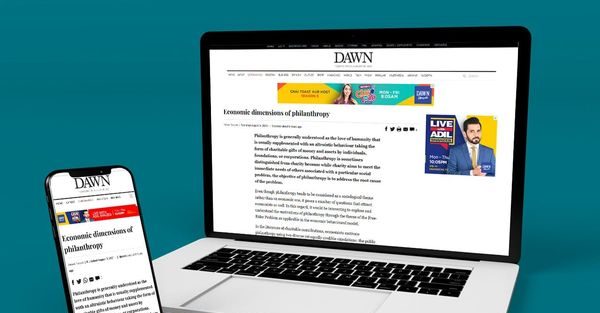Philanthropy is generally understood as the love of humanity that is usually supplemented with an altruistic behaviour taking the form of charitable gifts of money and assets by individuals, foundations, or corporations. Philanthropy is sometimes distinguished from charity because while charity aims to meet the immediate needs of others associated with a particular social problem, the objective of philanthropy is to address the root cause of the problem.
Even though philanthropy tends to be considered as a sociological theme rather than an economic one, it poses a number of questions that attract economists as well. In this regard, it would be interesting to explore and understand the motivations of philanthropy through the theme of the Free-Rider Problem as applicable in the economic behavioural model.
In the literature of charitable contributions, economists motivate philanthropy using two diverse yet equally credible simulations: the public goods model in which donors give/donate motivated by what their gifts accomplish, and the private consumption model in which donors give/donate motivated by how giving makes them feel. And now another model that has taken importance in philanthropic motivation is impact philanthropy.
Most of us donate to charity for the same reason that we give our money to the ice-cream vendor — the satisfaction and pleasure we get in return make the monetary sacrifice worthwhile
The economists agreed long ago that altruism, fellow feeling, and caring for others has a gigantic share in human inventiveness. Such intentions illuminate such questions as to why one has offspring, reasons of doing volunteer work, casting a vote, writing cheques to the charities, and taking jobs that do not pay a lot but that are rewarding in other, nonmonetary ways.
Economists assume that people are self-interested and since individuals have a choice in how they behave in a given situation, they must always make the choices that they think are the best at the time. This assumption, called the ‘axiom of rationality,’ thus provides the bedrock from which economic models of behaviour are formed.
Applying this framework to philanthropic behaviour, we can ask why would someone who works hard for his or her money simply turn around and give to others without expecting any return? Does not this contradict the assumption that individuals are self-interested? Maybe. But by the axiom of rationality, it is pertinent to first look for ways in which an individual believes that giving to charity is the best thing to do with that money at that time.
One possibility is that people desire more of the service provided by the charity. For instance, Shaukat Khanam Memorial Cancer Hospital, a charitable organisation, survives largely on donations. People donate to this cause in the form of meals, equipment, sponsoring a patient to monetary donations. Anyone can get the facilities, even without donating, and anyone who gives something is unlikely to notice any increase in quality of service as a result. The same example holds with Edhi Foundation.
It follows that a self-interested person is better off giving nothing and taking a ‘free ride’ on the donations of others. A free rider is often associated with public goods or goods that are both non-rival and non-excludable in consumptions. Hence, this alone cannot be an adequate explanation for why people give to charity.
A second reason is that individuals may be getting something directly from the charity in exchange for their contributions. For instance, big donors may get better seats in different gatherings, or donors to a university may get buildings named for them. While this must surely matter for large donors, most individuals only receive tokens (a pen or calendar), if anything, in exchange for donations.
A third reason could be that individuals get some internal satisfaction seeking to maximise their utility — a ‘warm-glow’ — from giving to their favoured charity, and the more they give, the better they feel. The term ‘‘warm glow’’ refers to a purely internal satisfaction that comes from the act of giving. This would mean that giving to charity is like buying any other good, such as chocolate. We easily accept that people have a natural taste for chocolates, so why not a natural taste for warm-glow? If we accept this, then it can be analysed as charitable giving just like any other consumer good — when income goes up people should want more, and when the price goes up people should want less.
Scholars have examined preferences for giving from a number of different approaches, and it seems that warm-glow is in fact a core economic motivation for giving. But what is it that produces the private benefit from giving? Warm-glow could stem from religious duty, from pressure at work or friends, as a signal of social status or to project a positive image to others. At the heart of all of these processes, however, seems to be a basic human interest in helping others or doing one’s share.
While the economics of philanthropy may seem more like an oxymoron, economics is about the choices one makes when he/she cannot have everything he/she wants, and the implications of those choices in market and nonmarket settings. As long as people do not have infinite amounts of time and money, economics will have something to say about how they behave in settings involving love and compassion, duty and honour. The essence of economics is remembering that few virtues are absolute —when they get more expensive, harder to do, or less pleasant, people will do less of them.
But most of us donate to charity for the same reason that we give our money to the ice-cream vendor or the car dealer — the satisfaction, utility, and pleasure we get in return make the monetary sacrifice worthwhile. That is, much of our giving stems from what might be called self-interested altruism, the joy of seeing others helped.
If we take the World Giving Index, Pakistan stands at 69th most generous country out of 128 nations while the Stanford Social Innovation Review quoting Pakistan Centre for Philanthropy (PCP) — Indigenous Individual Philanthropy study states that Pakistan, being a generous country contributes more than 1 per cent of its GDP to charity. Here one fact must be kept in view that these charitable activities have played a huge role in balancing the burden of economic crunch on low-income groups and to a great extent prove the above discussion.
This discussion was started by defining philanthropy as the love of humanity, which should undisputedly be a good thing. And yet, not everybody agrees. Critics from the left and the right question the rationale for subsidising charitable giving and worry about the political power of large foundations. Peter Drucker famously stated that “if you can’t measure it, you can’t improve it”. Thus it can be concluded that still more and better data is necessary for evaluating and improving philanthropy.
When a philanthropist values ‘making a difference or economic gamification,’ he or she benefits, to some degree, from need. This is the personal satisfaction for having ‘done the right thing’: one gives up what is rightfully theirs for a philanthropic cause and he/she feels good about it. As a result, philanthropists and the recipients of philanthropy can fall into a co-dependent relationship in which both benefit from the other.



